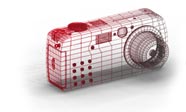 |
|
||
|
|
|
Main / Articles: Combat Red EyeRed eye: Everyone hates it, yet it's hard to avoid finding a few examples in every batch of pictures you take. That's unfortunate, especially when you find that an otherwise great picture of a long-distance relative looks like Linda Hamilton's character in the movie Children of the Corn. So what is red eye? How do you avoid it? Understanding Red Eye Eliminate Red Eye With Your Digital Camera There are other things you can do to minimize red eye as well. You can avoid shooting in a dark room or outdoors after dark, for instance. Red eye never happens in bright light. If you're ambitious, you might also want to look into getting an external flash for your digital camera. Red eye happens because the flash is very close to the lens, so light reflects directly back into the camera. If you can get the flash farther away from the lens--such as by mounting a flash on the camera's flash mount (called the hot shoe), holding it away from the camera on an extension cable, or "bouncing" the flash off the ceiling--you'll avoid red eye entirely. Image Editors to the Rescue From the menu, choose Adjust, Red-Eye Removal . In the Red-Eye Removal dialog box, you can see two images: the one of the left is the work image where you can apply the effect and the one on the right is a preview of the finished image. Grab the image on the right and drag it around until you can see the eyes. Then use the magnifying glass button on the left to zoom in until one or both eyes fill most of the screen. Be careful not to try dragging the image around by the image on the left, since clicking there will apply the red-eye tool. Now it's time to apply the red-eye treatment. In the left image, click in the middle of one of the eyes and drag the tool until you've made a circle about the same size as the red portion of the eye. After a moment, you'll see a preview of the new eye on the right image. From there, you can customize the eye by specifying its color, refining its size, and even adding a little glint. If you have a dog or cat with the evil eye, note that Paint Shop Pro even has an animal eye setting. Then repeat the process for the other eye. Article source: PCWorld |
| © Copyright 2026 ShutterMag.com All Rights Reserved. |
